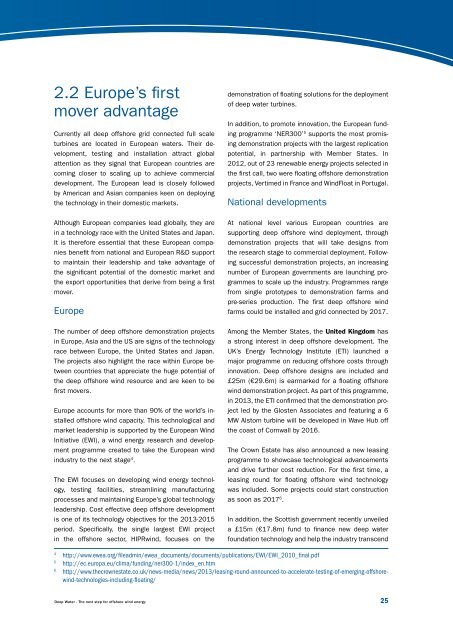Deep_Water
Deep_Water
Deep_Water
Create successful ePaper yourself
Turn your PDF publications into a flip-book with our unique Google optimized e-Paper software.
2.2 Europe’s first<br />
mover advantage<br />
Currently all deep offshore grid connected full scale<br />
turbines are located in European waters. Their development,<br />
testing and installation attract global<br />
attention as they signal that European countries are<br />
coming closer to scaling up to achieve commercial<br />
development. The European lead is closely followed<br />
by American and Asian companies keen on deploying<br />
the technology in their domestic markets.<br />
Although European companies lead globally, they are<br />
in a technology race with the United States and Japan.<br />
It is therefore essential that these European companies<br />
benefit from national and European R&D support<br />
to maintain their leadership and take advantage of<br />
the significant potential of the domestic market and<br />
the export opportunities that derive from being a first<br />
mover.<br />
Europe<br />
The number of deep offshore demonstration projects<br />
in Europe, Asia and the US are signs of the technology<br />
race between Europe, the United States and Japan.<br />
The projects also highlight the race within Europe between<br />
countries that appreciate the huge potential of<br />
the deep offshore wind resource and are keen to be<br />
first movers.<br />
Europe accounts for more than 90% of the world’s installed<br />
offshore wind capacity. This technological and<br />
market leadership is supported by the European Wind<br />
Initiative (EWI), a wind energy research and development<br />
programme created to take the European wind<br />
industry to the next stage 4 .<br />
The EWI focuses on developing wind energy technology,<br />
testing facilities, streamlining manufacturing<br />
processes and maintaining Europe’s global technology<br />
leadership. Cost effective deep offshore development<br />
is one of its technology objectives for the 2013-2015<br />
period. Specifically, the single largest EWI project<br />
in the offshore sector, HIPRwind, focuses on the<br />
demonstration of floating solutions for the deployment<br />
of deep water turbines.<br />
In addition, to promote innovation, the European funding<br />
programme ‘NER300’ 5 supports the most promising<br />
demonstration projects with the largest replication<br />
potential, in partnership with Member States. In<br />
2012, out of 23 renewable energy projects selected in<br />
the first call, two were floating offshore demonstration<br />
projects, Vertimed in France and WindFloat in Portugal.<br />
National developments<br />
At national level various European countries are<br />
supporting deep offshore wind deployment, through<br />
demonstration projects that will take designs from<br />
the research stage to commercial deployment. Following<br />
successful demonstration projects, an increasing<br />
number of European governments are launching programmes<br />
to scale up the industry. Programmes range<br />
from single prototypes to demonstration farms and<br />
pre-series production. The first deep offshore wind<br />
farms could be installed and grid connected by 2017.<br />
Among the Member States, the United Kingdom has<br />
a strong interest in deep offshore development. The<br />
UK’s Energy Technology Institute (ETI) launched a<br />
major programme on reducing offshore costs through<br />
innovation. <strong>Deep</strong> offshore designs are included and<br />
£25m (€29.6m) is earmarked for a floating offshore<br />
wind demonstration project. As part of this programme,<br />
in 2013, the ETI confirmed that the demonstration project<br />
led by the Glosten Associates and featuring a 6<br />
MW Alstom turbine will be developed in Wave Hub off<br />
the coast of Cornwall by 2016.<br />
The Crown Estate has also announced a new leasing<br />
programme to showcase technological advancements<br />
and drive further cost reduction. For the first time, a<br />
leasing round for floating offshore wind technology<br />
was included. Some projects could start construction<br />
as soon as 2017 6 .<br />
In addition, the Scottish government recently unveiled<br />
a £15m (€17.8m) fund to finance new deep water<br />
foundation technology and help the industry transcend<br />
4<br />
http://www.ewea.org/fileadmin/ewea_documents/documents/publications/EWI/EWI_2010_final.pdf<br />
5<br />
http://ec.europa.eu/clima/funding/ner300-1/index_en.htm<br />
6<br />
http://www.thecrownestate.co.uk/news-media/news/2013/leasing-round-announced-to-accelerate-testing-of-emerging-offshorewind-technologies-including-floating/<br />
<strong>Deep</strong> <strong>Water</strong> - The next step for offshore wind energy 25


